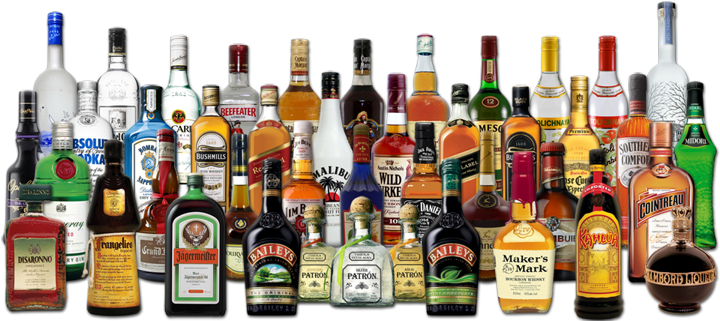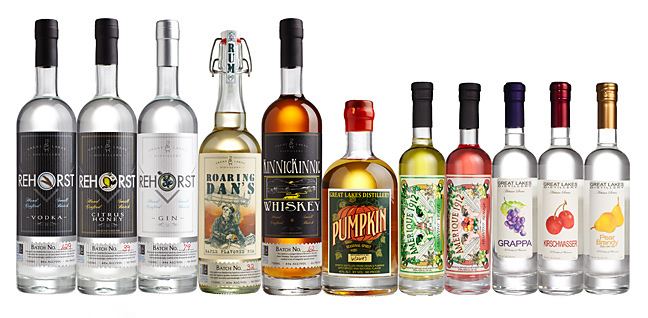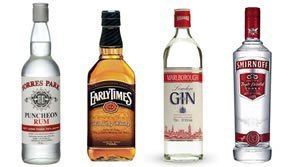 | ||
Similar Whisky, Liqueur, Vodka, Wine, Beer | ||
A distilled beverage, spirit, liquor, hard liquor or hard alcohol is an alcoholic beverage produced by distillation of a mixture produced from alcoholic fermentation. This process purifies it and removes diluting components like water, for the purpose of increasing its proportion of alcohol content (commonly expressed as alcohol by volume, ABV). As distilled beverages contain more alcohol, they are considered "harder" – in North America, the term hard liquor is used to distinguish distilled beverages from undistilled ones.
Contents
- Nomenclature
- Etymology
- Precursors
- True distillation
- Government regulation
- Microdistilling
- Flammability
- Serving
- Alcohol consumption by country
- Short term effects
- Long term effects
- References

As examples, this term does not include beverages such as beer, wine, and cider, as they are fermented but not distilled. These all have relatively low alcohol content, typically less than 15%. Brandy is a spirit produced by the distillation of wine, and has an ABV of over 35%. Other examples of distilled beverages include bourbon, vodka, gin, rum, tequila, mezcal, whisky, scotch, and moonshine. (Also see list of alcoholic drinks, and liquors by national origin. )
Nomenclature

The term spirit refers to a distilled beverage that contains no added sugar and has at least 20% alcohol by volume (ABV).

Distilled beverages bottled with added sugar and added flavorings, such as Grand Marnier, Frangelico, and American schnapps, are known instead as liqueurs.
Distilled beverages generally have an alcohol concentration higher than 30%. Beer and wine, which are not distilled beverages, are limited to a maximum alcohol content of about 20% ABV, as most yeasts cannot reproduce when the concentration of alcohol is above this level; as a consequence, fermentation ceases at that point.
Etymology
The origin of "liquor" and its close relative "liquid" was the Latin verb liquere, meaning "to be fluid". According to the Oxford English Dictionary, an early use of the word in the English language, meaning simply "a liquid", can be dated to 1225. The first use the OED mentions of its meaning "a liquid for drinking" occurred in the 14th century. Its use as a term for "an intoxicating alcoholic drink" appeared in the 16th century.
The term "spirit" in reference to alcohol stems from Middle Eastern alchemy. These alchemists were more concerned with medical elixirs than with transmuting lead into gold. The vapor given off and collected during an alchemical process (as with distillation of alcohol) was called a spirit of the original material.
Precursors
The first clear evidence of distillation comes from Greek alchemists working in Alexandria in the 1st century AD, although the Chinese may have independently developed the process around the same time. Distilled water was described in the 2nd century AD by Alexander of Aphrodisias. The Alexandrians were using a distillation alembic or still device in the 3rd century AD.
The medieval Arabs learned the distillation process from the Alexandrians and used it extensively, but there is no evidence that they distilled alcohol.
Freeze distillation involves freezing the alcoholic beverage and then removing the ice. The freezing technique had limitations in geography and implementation limiting how widely this method was put to use.
True distillation
The earliest evidence of true distillation of alcohol comes from the School of Salerno in southern Italy during the 12th century. Again, the Chinese may not have been far behind, with archaeological evidence indicating the practice of distillation began during the 12th century Jin or Southern Song dynasties. A still has been found at an archaeological site in Qinglong, Hebei, dating to the 12th century.
Fractional distillation was developed by Taddeo Alderotti in the 13th century. The production method was written in code, suggesting that it was being kept secret.
In 1437, "burned water" (brandy) was mentioned in the records of the County of Katzenelnbogen in Germany. It was served in a tall, narrow glass called a Goderulffe.
Claims upon the origin of specific beverages are controversial, often invoking national pride, but they are plausible after the 12th century AD, when Irish whiskey and German brandy became available. These spirits would have had a much lower alcohol content (about 40% ABV) than the alchemists' pure distillations, and they were likely first thought of as medicinal elixirs. Consumption of distilled beverages rose dramatically in Europe in and after the mid-14th century, when distilled liquors were commonly used as remedies for the Black Death. Around 1400, methods to distill spirits from wheat, barley, and rye beers, a cheaper option than grapes, were discovered. Thus began the "national" drinks of Europe: jenever (Belgium and the Netherlands), gin (England), Schnaps (Germany), grappa (Italy),borovička (Slovakia), horilka (Ukraine), akvavit/snaps (Scandinavia), vodka (Poland and Russia), ouzo (Greece), rakia (the Balkans), and poitín (Ireland). The actual names emerged only in the 16th century, but the drinks were well known prior to then.
Government regulation
It is legal to distill beverage alcohol as a hobby for personal use in some countries, including Italy, New Zealand, and the Netherlands.
In the United States, all states allow unlicensed individuals to make their own beer, and some also allow unlicensed individuals to make their own wine, although in some places that do not prohibit home manufacture at the state level, local governments may prohibit it. However, it is illegal to distill beverage alcohol without a license anywhere in the US. In some jurisdictions, it is also illegal to sell a still without a license.
Microdistilling
Microdistilling (also known as craft distilling) as a trend began to develop in the United States following the emergence and immense popularity of microbrewing and craft beer in the last decades of the 20th century. It is different from megadistilling in the quantity and quality of output.
Flammability
Liquor that contains 40% ABV (80 US proof) will catch fire if heated to about 26 °C (79 °F) and if an ignition source is applied to it. This temperature is called its flash point. The flash point of pure alcohol is 16.6 °C (61.9 °F), less than average room temperature.
The flash points of alcohol concentrations from 10% ABV to 96% ABV are:
Serving
Distilled beverages can be served:
Alcohol consumption by country
The World Health Organization measures and publishes alcohol consumption patterns in different countries. The WHO measures alcohol consumed by persons 15 years of age or older and reports it on the basis of liters of pure alcohol consumed per capita in a given year in a country.
Short-term effects
Distilled spirits contain ethyl alcohol, the same chemical that is present in beer and wine and as such, spirit consumption has short-term psychological and physiological effects on the user. Different concentrations of alcohol in the human body have different effects on a person. The effects of alcohol depend on the amount an individual has drunk, the percentage of alcohol in the spirits and the timespan that the consumption took place, the amount of food eaten and whether an individual has taken other prescription, over-the-counter or street drugs, among other factors. Drinking enough to cause a blood alcohol concentration (BAC) of 0.03%-0.12% typically causes an overall improvement in mood and possible euphoria, increased self-confidence and sociability, decreased anxiety, a flushed, red appearance in the face and impaired judgment and fine muscle coordination. A BAC of 0.09% to 0.25% causes lethargy, sedation, balance problems and blurred vision. A BAC from 0.18% to 0.30% causes profound confusion, impaired speech (e.g., slurred speech), staggering, dizziness and vomiting. A BAC from 0.25% to 0.40% causes stupor, unconsciousness, anterograde amnesia, vomiting, and respiratory depression (potentially life-threatening). Death may occur due to inhalation of vomit (pulmonary aspiration) while unconscious. A BAC from 0.35% to 0.80% causes a coma (unconsciousness), life-threatening respiratory depression and possibly fatal alcohol poisoning. As with all alcoholic beverages, driving under the influence, operating an aircraft or heavy machinery increases the risk of an accident; many countries have penalties against drunk driving.
Long-term effects
The main active ingredient of distilled spirits is alcohol, and therefore, the health effects of alcohol apply to spirits. Drinking small quantities of alcohol (less than one drink in women and two in men) is associated with a decreased risk of heart disease, stroke, diabetes mellitus, and early death. Drinking more than this amount; however, increases the risk of heart disease, high blood pressure, atrial fibrillation, and stroke. Risk is greater in younger people due to binge drinking which may result in violence or accidents. About 3.3 million deaths (5.9% of all deaths) are believed to be due to alcohol each year.
Alcoholism also known as "alcohol use disorder" is a broad term for any drinking of alcohol that results in problems. It was previously divided into two types: alcohol abuse and alcohol dependence. In a medical context, alcoholism is said to exist when two or more of the following conditions is present: a person drinks large amounts over a long time period, has difficulty cutting down, acquiring and drinking alcohol takes up a great deal of time, alcohol is strongly desired, usage results in not fulfilling responsibilities, usage results in social problems, usage results in health problems, usage results in risky situations, withdrawal occurs when stopping, and alcohol tolerance has occurred with use. Alcoholism reduces a person's life expectancy by around ten years and alcohol use is the third leading cause of early death in the United States. No professional medical association recommends that people who are nondrinkers should start drinking wine.
While lower quality evidence suggest a cardioprotective effect, no controlled studies have been completed on the effect of alcohol on the risk of developing heart disease or stroke. Excessive consumption of alcohol can cause liver cirrhosis and alcoholism. The American Heart Association "cautions people NOT to start drinking ... if they do not already drink alcohol. Consult your doctor on the benefits and risks of consuming alcohol in moderation."
